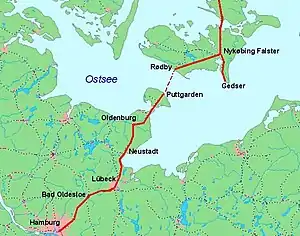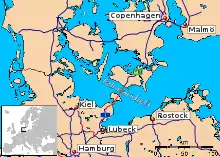Vogelfluglinie
The Vogelfluglinie (German) or Fugleflugtslinjen (Danish) is a transport corridor between Copenhagen, Denmark, and Hamburg, Germany.


As the Danish and German names (literally: bird flight line) imply, the corridor is also an important bird migration route between arctic Scandinavia and Central Europe.
Ferry link
The core of the connection is the 19-kilometre (12 mi) ferry link between Rødby (Denmark) and Puttgarden (Germany). The line is operated by Scandlines. Ferries take 45 minutes and operate twice an hour, 24 hours a day.
The projected Fehmarn Belt Fixed Link, an undersea tunnel, will replace the ferries. Danish-German negotiations on June 29, 2007 culminated in an agreement to complete the link by 2028, essentially on the basis of Danish funding.
Landside connections
Road
The road connection consists of:
- European route E47 on the Danish side.
- Autobahn A1 (European routes E 47 and E22) on the German side, and the two-lane Bundesstraße 207/E 47 on the northernmost section. An additional 10 km (6.2 mi) of motorway was completed by 2008, still leaving the last 25 km (16 mi) a two-lane road.
Railway
The rail connection consists of:
- 118 km (73 mi) of double track from Copenhagen to Vordingborg; maximum speed 160 to 180 km/h (99 to 112 mph); electrified for 64 km (40 mi) to Ringsted
- 65 km (40 mi) of single track from Vordingborg to Rødby; maximum speed 120 km/h (75 mph)
- 89 km (55 mi) of single track from Puttgarden to Lübeck
- 64 km (40 mi) of double track from Lübeck to Hamburg, electrified.
Until 2019, three to five EuroCity trains a day in each direction used train ferries to provide passenger services between Copenhagen and Hamburg, operated with DBAG Class 605 trains by Deutsche Bahn (out of service since 2017) and Danish IC3 trains. With the completion of the Great Belt Bridge freight trains are no longer directed via Rødby-Puttgarden, but via Funen and Jutland. Since the end of 2019, passenger trains have also used this route, which is 160 km (99 mi) longer but around 20 minutes faster and allows longer trains.[1] Only some of the IC3 trains were capable of going to Germany.[2]
These current bridges and tunnels are part of the connection:
- Masnedsund Bridge and Storstrøm Bridge, Sealand/Falster (rail)
- Farø Bridges, Sealand/Falster (motorway E47)
- Frederick IX Bridge, Falster/Lolland (two-lane road and rail)
- Guldborgsund Tunnel, Falster/Lolland (motorway E47)
- Rødbyhavn (harbour, Denmark)
- Puttgarden (harbour, Germany)
- Fehmarn Sound bridge, Fehmarn/Germany (two-lane road E47 and rail)
History
Proposals for a more direct "bird flight line" date back from the 1920s. Construction was started on the Danish side in 1941 after the Nazi occupation force pushed the matter, but work was halted again in 1946. After World War II, Warnemünde (near Rostock) was included in the territory of East Germany. Political divisions made traffic between Denmark and West Germany via Warnemünde inconvenient.
From 1951 to 1963 a ferry line from Gedser to Großenbrode operated as a temporary solution. In addition, traffic between Copenhagen and Hamburg would either be directed over the Great Belt ferry, Funen and Jutland or the Gedser-Warnemünde ferry. Construction of the "bird flight line" was restarted in 1949 and completed in 1963.
On December 14, 2019 at 20:02 the last train from DSB and Deutsche Bahn arrived in Rødbyhavn. The trains between Hamburg and Copenhagen will run via Funen and Jutland until the Fehmarnbelt connection is completed. The rail ferry was discontinued because service would have been degraded massively while works on Sydbanen are ongoing.
Beeline in pictures
- Vogelfluglinie/Fugleflugtslinien
 M/S Prinsesse Benedikte, one of the ferries
M/S Prinsesse Benedikte, one of the ferries A Danish IC3 train in Hamburg Central Station
A Danish IC3 train in Hamburg Central Station The ICE TD/type 605 formerly used on the Vogelfluglinie
The ICE TD/type 605 formerly used on the Vogelfluglinie

 Planned route of the Fehmarn Belt Fixed Link
Planned route of the Fehmarn Belt Fixed Link IC3 trains on the boat
IC3 trains on the boat
References
- "The train link between Germany & Scandinavia..." The Man in Seat 61. Retrieved 13 January 2020.
- "Med en af Europas sidste jernbanefærger" (in Danish). 2019-11-28.
External links
 Media related to Fugleflugtslinjen at Wikimedia Commons
Media related to Fugleflugtslinjen at Wikimedia Commons- Scandlines